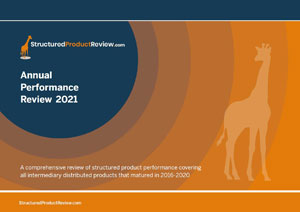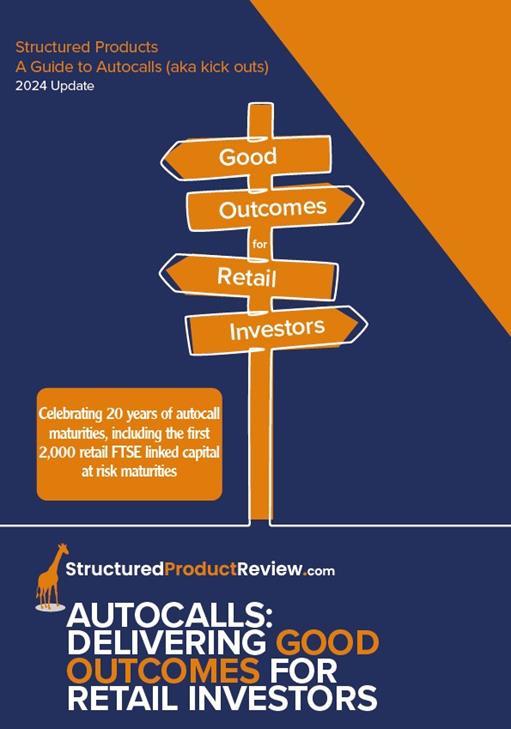Volatility is a statistical measure of the tendency for the value of an asset’s price to move in either direction away from its average price over time.
If an asset has high volatility the price of the asset will be spread over a greater range of values, whilst low volatility suggests that the price deviates across a smaller range. A Targeted Absolute Return fund, demonstrated by the IA Targeted Absolute Return sector average shown in red on the chart below has low volatility, whilst a Commodities fund, demonstrated by the IA Commodity/Natural Resources sector average shown in blue, has high volatility. This is because there are greater swings in price from the returns over a given time period.
Source: FE Analytics, Total Return, Bid-Bid
The price of a structured investment is in part determined by the implied volatility of the underlying asset. Unlike historic volatility, which measures the actual variation over a given timeframe in the past, implied volatility is a measure of the expected range of price movements in the near future. For the probability models used to price the Financial Derivative Instruments (FDIs) present within structured investments, the implied volatility looks at the 34% most likely price movements in either direction, giving a span of the 68% (one standard deviation) most likely potential price movements at a given point in time.
The sensitivity to implied volatility of the FDIs within a structured investment is known as Vega. Academic studies suggest that the Vega within a structured investment is typically less than that of the underlying asset, and their pricing therefore tends to be less volatile than that of the underlying index. This is distinct from the additional risk exposure taken through the adoption of counterparty credit risk, and interest rate risk which also contribute towards the pricing of the structured investment.
As well as affecting the pricing of a structured investment, volatility also affects the potential returns offered by structured investments. This can be demonstrated by comparing two structured products which, despite having the same shape (i.e. the same maturity reference level of the initial level in each case; the same frequency of early maturity observations and the same capital protection barrier) began at different times, when volatility in the FTSE 100 and index position was very different.
The first offered a 16.6% return for each year held, maturing on the first of the pre-defined observation dates that the FTSE 100 Index was above the initial index level (6,721.17).
The second has similar maturity parameters albeit with an initial index and maturity trigger level of 7,203.29 but offered a lower potential 10.75% return for each year held.
Whilst these two strategies had some differing factors, not least different counterparties the large variance in return offered can largely be attributed to the volatility of the underlying asset (the FTSE 100 Index) at the time they were structured. Volatility was much greater in December 2018, when the first was created, but had fallen considerably by the time the second was introduced in May 2019.
So, whilst structured investment terms can vary according to volatility in the underlying measure, over the medium to long term their pricing tends to be less volatile than the underlying index itself. This can be comforting when markets have been powering ahead and investors are worried that a downturn may be coming. They have the knowledge that their investments are likely to be less volatile than the market, and they are still accumulating potential gains whilst giving time for the market to recover. Not to mention their capital having a degree of contingent protection.
Conversely, they can be a good investment to use in bear markets, where the strike levels are low and volatility is high, leading to improved terms, and again the inbuilt protections can provide comfort to those nervous of investing in a falling market. Of course, when markets are neither relatively high nor low, the predefined nature of the returns investors can expect gives them a unique advantage over many alternatives.
Structured investments put capital at risk.
Past performance is not a guide to future performance.
Also in this section
- How old is too old? Are structured products to die for?
- Product focus - October 2024
- Q3 2024 Issuance
- Q3 2024 maturity results
- A share of spread bets on steroids?
- Product focus - September 2024
- Maturities of the month - August 2024
- Right on time
- Product focus - August 2024
- Keep calm and zoom out
- 2,000 and counting
- Q2 2024 maturity results
- 20 years of autocall maturities
- Product focus - June 2024
- Fixed income or interest?
- Maturities of the month - May 2024
- The barrier debate - revisited
- Product focus - April 2024
- Maturities of the month - April 2024
- Time to call
- I don't believe markets are ever too high for Structured products!
- Notes on counterparty exposure
- Return of Nikkei
- Q1 2024 issuance
- Q1 2024 maturity results
- Structured Products – AAAAAGH!
- Hop in CIBC
- Re-enter Santander
- How to build a financial fortune - revisited
- Issuance in 2023
- Where's the risk?
- Questionable offerings
- Challenging the case against structured products - 'Loss of dividends'
- Navigating the investment landscape
- Challenging the case against structured products - Counterparty risk
- 6-year autocalls approaching final destination
- 1,750 FTSE capital at risk autocall maturities
- The leopard that changed her spots
- Q3 2023
- Challenging the case against structured products - Keydata
- Dilemmas for UK IFA's and the unique role of Structured Products
- 'High charges'
- Precipice bonds
- Intro
- FTSE 100 Contingent Income
- Indexing the indices
- Something different
- Investing through volatility
- 100 10:10s
- The best or worst?
- The 10%/25% 'Rule' that never was
- Structured products and the yield curve
- Fixed income: Capital at risk?
- Prospects for UK inflation - and fun with A.I!
- The Barrier Debate
- More Deposits for now
- Last of the Americans
- What if?
- Time heals all wounds, we hope...
- How to diversify portfolios using structured products?
- The Proof Is In The Pudding...
- Debunking Structured Misconceptions
- 1,500 FTSE Capital-at-Risk Autocall Maturities
- Q3 2022 Maturity Results
- What do we prefer?
- Deposits vs Capital ‘Protected’
- There’s time yet…
- Where did you invest your clients?
- A Six-Month Reflection
- Return of the Rev Con
- Happy 2nd Birthday FTSE CSDI
- Q2 2022 Maturity Results
- The best and worst yet still the best
- Critique my Suitability - Mariana 10:10 Plan June 2022 (Option 2)
- 10/10 for 55 10:10’s
- Q1 2022 Maturity Results
- 'How to build a financial fortune': a follow up
- Critique my Suitability - Mariana 10:10 Plan April 2022 (Option 2)
- 2021 Capital-at-Risk Autocall Maturity Review
- An unwelcome return...
- CSDI's First Birthday
- Bon Anniversaire
- Introducing the FTSE Custom 100 Synthetic 3.5% Fixed Dividend Index
- Q3 2021 Maturity Results
- Critique my Suitability - Mariana 10:10 Plan October 2021 (Option 2)
- Blurring the lines...
- Beware of false knowledge; it is more dangerous than ignorance
- Good news, bad news...
- Certainty is Certainly a Benefit
- Critique my Suitability - Mariana 10:10 Plan September 2021 (Option 2)
- A Twenty-Year Progression
- Q2 2021 Maturity Results
- Nine 8:8s Post Positive Returns in Falling Markets
- Critique my Suitability
- Q1 2021 Maturity Results
- Morgan Stanley’s Marvelous Maturity Medley
Current Products
We review the UK's retail structured investment sector, providing pertinent support for Professional Advisers and relevant research tools.
View all ⟶


